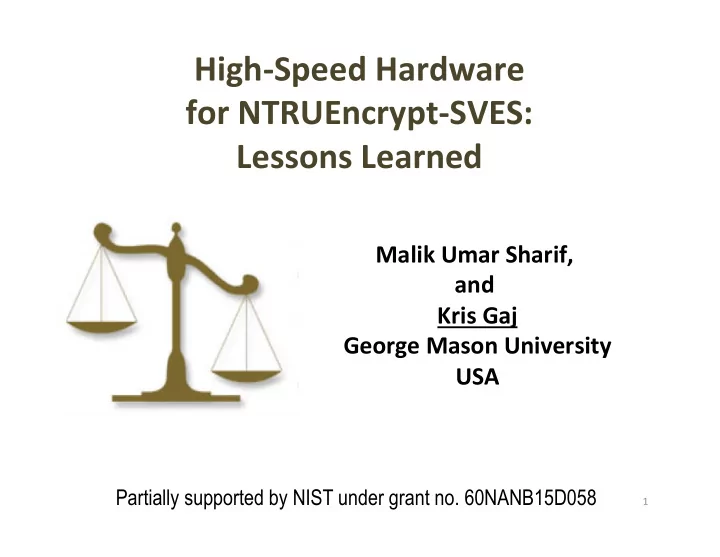

High-Speed Hardware for NTRUEncrypt-SVES: Lessons Learned Malik Umar Sharif, and Kris Gaj George Mason University USA Partially supported by NIST under grant no. 60NANB15D058 1
Co-Author Malik Umar Sharif PhD Student in the Cryptographic Engineering Research Group (CERG) at GMU
Our Objective Paving the way for the future comprehensive, fair, and efficient hardware benchmarking of PQC algorithms through 1. Uniform Hardware API inspired by the APIs used in the SHA-3 and CAESAR competitions 2. Efficient Methodology based on the manually written VHDL/Verilog code or High-Level Synthesis 3
Proposed Uniform Hardware API Communication Protocol Minimum Compliance Criteria Encryption & decryption, or • Signature generation & verification External key generation (e.g., in software) • Permitted data port widths, etc. • Interface Timing Characteristics Specification: https://cryptography.gmu.edu/athena 4
Algorithm Selected for a Pilot Study NTRUEncrypt Short Vector Encryption Scheme (SVES) fully compliant with IEEE 1363.1 Standard Specification for Public Key Cryptographic Techniques Based on Hard Problems over Lattices, 2009 Parameter sets: • Optimized for speed • 192-bit security: ees1087ep1: p=3, q=2048, N=1087, df=dr=63 • 256-bit security: ees1499ep1: p=3, q=2048, N=1499, df=dr=79 Security Public Key Private Key Level Size Size 192 1495 B 174 B 256 2062 B 218 B 5
Implementation Assumptions • Optimization for speed • Minimum Latency • Maximum Number of Operations per Second • Application: high-end servers supporting a very large number of TLS, IPSec, and other protocol transactions • Key generation performed externally, e.g., in software • No countermeasures against side-channel attacks 6
NTRUEncrypt – Flow Diagram for Encryption Message Random Truncated Msg Bits Object ID Public Message Length Zero Key Random Padding Bits Blinding Polynomial Generation Method Bits to Mask Generation Ternary Digits Public Function Key Ciphertext 7
NTRUEncrypt – Flow Diagram for Decryption Truncated Private Public Key Key Decrypted Object Message ID Decrypted Ciphertext Random Decrypted Bits Msg Length Public Key Ternary Digits to Bits Mask Generation Function Ciphertext 8
NTRUEncrypt – Top-Level Block Diagram IDCU – Input DFU – Data Data Formatting Unit Conversion Unit Top-Level ODCU – Block Diagram Output Data Conversion SIPO – Serial In Parallel Out Unit PISO – Parallel In Serial Out 9
Block Diagram of Polynomial Multiplier E: Random Polynomial, r D: Private Key, f E: Public Key, h D: Ciphertext, e Execution Time: E: 3*(2*dr) D: Ciphertext, e D: 3*(2*df) E: R=r*h D: f*e 10
Block Diagram of Blinding Polynomial Generation Method (BPGM) / Mask Generation Function (MGF) BWC – Bit Width Conversion O2T – Octets to Ternary Digits PISO – Parallel In Serial Out Implementation of SHA-2 modified to share computations for hashing of strings starting from the same common substring 11
Implementation Platforms Hardware: FPGA Family: Xilinx Kintex-7 UltraSCALE Device: XCKU035-FFVA1156 Technology: 20nm CMOS Software: Cortex A9 ARM Core of Zynq 7020 12
Major Component Operations Resource Utilization & Performance Operation LUTs: Slices Clk Freq. [MHz] Poly Mult 140,512 : 25,099 74.4 BPGM 1971 : 421 171.0 MGF B2T 64 : 34 904.0 T2B 64 : 35 984.3 Poly Add 1338 : 272 316.3 Poly Sub 1 1221 : 258 331.2 Poly Sub 2 74 : 64 540.2 PolyMult contributes to over 90% of area and limits clock frequency 13
Comparison with Previous Work on Implementing Polynomial Multiplication Source Resources Clk Freq. [MHz] Latency [cycles] Latency [µs] Parameter set: ees1499ep1 Liu et al., 2016 83,949 LEs 63.6 867 13.6 This Work 140,512 LUTs 74.4 474 6.4 Speed-up x1.17 x1.83 x 2.14 Parameter set: ees1087ep1 Liu et al., 2016 60,876 LEs 73.7 638 8.7 This Work 140,512 LUTs 74.4 378 5.1 Speed-up x1.01 x1.69 x 1.70 B. Liu and H. Wu, “Efficient Multiplicaover Truncated Polynomial Ring for NTRUEncrypt System,” IEEE International Symposium on Circuits and Systems, ISCAS 2016 14
Hash Function Bottleneck in Hardware Software • Poly Mult amounts to about 90% of the total execution time Hardware • Execution time dominated by hash-based Ø MGF: Mask Generation Function: 44% Ø BPGM: Blinding Polynomial Generation Method: 39.5% • Poly Mult almost completely overlapped with the computations of BPGM through the use of pipelining • Poly Mult naturally parallelizable • Hash function naturally sequential 15
Possible Improvements To Address the Hash Function Bottleneck: Architecture-Level: • Unrolled Implementation of SHA-2 Algorithmic-Level (changes in the IEEE standard required): • SHA-3 instead of SHA-2 • Pseudorandom function based on the pipelined AES To Address Other Encountered Problems: Algorithmic-Level (changes in the IEEE standard required): • Using SHA-2 instead of SHA-1 in lower-security parameter sets • Eliminating (or at least reducing) the dependence of the execution time on message size 16
Conclusions • First hardware implementation of the full NTRUEncrypt- SVES scheme • Hardware optimization for speed revealed the hash function bottleneck • Changes in the NTRUEncrypt standards may be required to overcome this bottleneck • New PQC Hardware API, paving the way for the fair evaluation of candidates in the NIST standardization process 17
Thank you! http:/cryptography.gmu.edu http:/cryptography.gmu.edu/athena 18
Recommend
More recommend